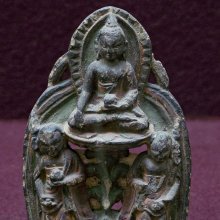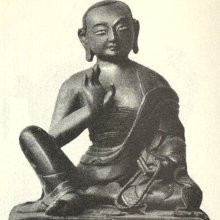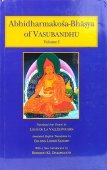Shariputra, Sāriputta, Śāriputra: 8 definitions
Introduction:
Shariputra means something in Buddhism, Pali, Hinduism, Sanskrit. If you want to know the exact meaning, history, etymology or English translation of this term then check out the descriptions on this page. Add your comment or reference to a book if you want to contribute to this summary article.
The Sanskrit term Śāriputra can be transliterated into English as Sariputra or Shariputra, using the IAST transliteration scheme (?).
Images (photo gallery)
In Buddhism
Theravada (major branch of Buddhism)
Source: Pali Kanon: Pali Proper Names1. Sariputta Thera. The chief disciple (aggasavaka) of Gotama - Buddha. He is also called Upatissa, which was evidently his personal name (M.i.150). The commentators say that Upatissa was the name of his village and that he was the eldest son of the chief family in the village, but other accounts give his village as Nalaka. His father was the brahmin, Vanganta (DhA.ii.84), and his mother, Rupasari. It was because of his mothers name that he came to be called Sariputta. In Sanskrit texts his name occurs as Sariputra, Saliputra, Sarisuta, Saradvatiputra. In the Apadana (ii.480) he is also called Sarisambhava.
The name Upatissa is hardly ever mentioned in the books. He had three younger brothers - Cunda, Upasena, and Revata (afterwards called Khadiravaniya) - and three sisters - Cala, Upacala and Sisupacala; all of whom joined the Order. DhA.ii.188; cf. Mtu.iii.50; for details of them see s.v.; mention is also made of an uncle of Sariputta and of a nephew, both of whom he took to the Buddha, thereby rescuing them from false views (DhA.ii.230 2); Uparevata was his nephew (SA.iii.175).
The story of Sariputtas conversion and the account of his past lives, which prepared him for his eminent position as the Buddhas Chief Disciple, have been given under Maha Moggallana. Sariputta had a very quick intuition, and he became a sotapanna immediately after hearing the first two lines of the stanza spoken by Assaji. After his attainment of sotapatti, Kolita (Moggallana) wished to go with him to Veluvana to see the Buddha, but Sariputta, always grateful to his teachers, suggested that they should first seek their teacher, Sanjaya, to give him the good news and go with him to the Buddha. But Sanjaya refused to fall in with this plan. Moggallana attained arahantship on the seventh day after his ordination, but it was not till a fortnight later that Sariputta became an arahant. He was staying, at the time, with the Buddha, in the Sukarakhatalena in Rajagaha, and he reached his goal as a result of hearing the Buddha preach the Vedanapariggaha Sutta to Dighanakha. This account is summarized from DhA.i.73 ff.; AA.i.88 ff.; ThagA.ii.93 ff. Ap.i.15ff.; the story of their conversion is given at Vin.i.38ff.
In the assembly of monks and nuns, Sariputta was declared by the Buddha foremost among those who possessed wisdom (etadaggam mahapannanam, A.i.23). He was considered by the Buddha as inferior only to himself in wisdom. SA.ii.45; his greatest exhibition of wisdom followed the Buddhas descent from Tavatimsa to the gates of Sankassa, when the Buddha asked questions of the assembled multitude, which none but Sariputta could answer. But some questions were outside the range of any but a Buddha (DhA.iii.228 f.; cf. SNA.ii.570f.).
Theravāda is a major branch of Buddhism having the the Pali canon (tipitaka) as their canonical literature, which includes the vinaya-pitaka (monastic rules), the sutta-pitaka (Buddhist sermons) and the abhidhamma-pitaka (philosophy and psychology).
Mahayana (major branch of Buddhism)
Source: Wisdom Library: Maha Prajnaparamita SastraŚāriputra (शारिपुत्र) is the name of a disciple of the Buddha according to the 2nd century Mahāprajñāpāramitāśāstra (chapter XV). Accordingly, “Of all the disciples of the Buddha, Śāriputra is by far the foremost in wisdom (prajñā). A stanza of the Buddha says: ‘Except for the Buddha Bhagavat, the knowledge (jñāna) of all beings would not equal a sixteenth part compared with the wisdom (prajñā) and learning (bahuśruta) of Śāriputra’”.
Also, “Śāriputra possessed great qualities (guṇa). In his youth, at the age of eight, he recited the eighteen kinds of sacred books and understood the meaning of all the treatises”.
Note: Śāriputra, also called Upatiṣya, was the son of Tiṣya and Śārī. The latter’s father was Māṭhara, a Brāhmin from Nalanda, and her brother was Mahākauṣṭhila, surnamed Dīrghanakha.

Mahayana (महायान, mahāyāna) is a major branch of Buddhism focusing on the path of a Bodhisattva (spiritual aspirants/ enlightened beings). Extant literature is vast and primarely composed in the Sanskrit language. There are many sūtras of which some of the earliest are the various Prajñāpāramitā sūtras.
Tibetan Buddhism (Vajrayana or tantric Buddhism)
Source: Wisdom Library: Tibetan BuddhismŚāriputra (शारिपुत्र) is the name of a Śrāvaka mentioned as attending the teachings in the 6th century Mañjuśrīmūlakalpa: one of the largest Kriyā Tantras devoted to Mañjuśrī (the Bodhisattva of wisdom) representing an encyclopedia of knowledge primarily concerned with ritualistic elements in Buddhism. The teachings in this text originate from Mañjuśrī and were taught to and by Buddha Śākyamuni in the presence of a large audience (including Śāriputra).

Tibetan Buddhism includes schools such as Nyingma, Kadampa, Kagyu and Gelug. Their primary canon of literature is divided in two broad categories: The Kangyur, which consists of Buddha’s words, and the Tengyur, which includes commentaries from various sources. Esotericism and tantra techniques (vajrayāna) are collected indepently.
General definition (in Buddhism)
Source: Wisdom Library: BuddhismShariputra was one of the most important of Buddha's disciples. He was originally a disciple of Sanjaya and may have been influential in the development of early Buddhist skepticism. Several of his discourses are philosophically important.
Source: Buddhist Door: GlossarySariputra in Sanskrit, Sariputta in Pali. He was born in a Brahman family near Rajagaha. At the age of 17, he mastered all Vedic doctrines. In seeking a good teacher, he studied under one of the six great non Buddhist teachers called Sanjaya. He met Shakyamuni with the aid of Assaji, one of the Five Bhiksus. He then became one of the Ten Great Disciples of Shakyamuni, noted for his wisdom and learning. He was also the right hand attendant on Shakyamuni. He died before Shakyamuni entered Nirvana. He figures prominently in certain sutras. He is represented as standing with Maudgalyayana by the Buddha when entering Nirvana. He is to reappear as Padmaprabha Buddha.Languages of India and abroad
Sanskrit dictionary
Source: Cologne Digital Sanskrit Dictionaries: Edgerton Buddhist Hybrid Sanskrit DictionaryŚāriputra (शारिपुत्र).—(= Pali Sāriputta; also Śāli°, Śāradva- tī-p°, Śārisuta), name of one of Buddha's two chief disciples, the other being (Mahā-)Maudgalyāyana; orig. named Upatiṣya, q.v. for story of his conversion; once also called Tiṣya, q.v. (6): Mahāvyutpatti 1032; Mahāvastu i.45.7; iii.41.6; 57.16 ff.; 94.1 ff.; 102.13; 255.15; 268.5; 375.7; (Senart always Śāri°, but usually some, often all, of his mss. Śāli°;) Saddharmapuṇḍarīka 2.2; 29.2 ff.; 60.1 ff.; 264.17 ff.; Lalitavistara 1.12; 443.13; Divyāvadāna 153.5; 182.21; 268.6; 314.15 ff.; 330.6 ff.; 394.21 ff.; 486.25 ff.; 542.24 ff.; Avadāna-śataka ii.69.7 etc.; Sukhāvatīvyūha 2.6; 92.5; Karmavibhaṅga (and Karmavibhaṅgopadeśa) 161.17. Why is he never called Mahā-Ś° in [Buddhist Hybrid Sanskrit] or Pali, when Maudgalyāyana, Kātyāyana, Kāśyapa, and other disciples so often have the prefix Mahā-?
--- OR ---
Śāriputra (शारिपुत्र) or Śāli-putra.—: Avadāna-śataka i.241.7, and ms. ii.186.7; mss. of Mahāvastu also often Śāli°.
Source: Cologne Digital Sanskrit Dictionaries: Monier-Williams Sanskrit-English DictionaryŚāriputra (शारिपुत्र):—[=śāri-putra] [from śāri > śāra] m. Name of one of the two chief disciples (Agra-śrāvaka), of Gautama Buddha (the other being Maudgalyāyana), [Monier-Williams’ Buddhism 47.]
[Sanskrit to German]
Sanskrit, also spelled संस्कृतम् (saṃskṛtam), is an ancient language of India commonly seen as the grandmother of the Indo-European language family (even English!). Closely allied with Prakrit and Pali, Sanskrit is more exhaustive in both grammar and terms and has the most extensive collection of literature in the world, greatly surpassing its sister-languages Greek and Latin.
See also (Relevant definitions)
Partial matches: Shari, Putra, Carin.
Starts with: Shariputrabhidharma.
Ends with: Mahashariputra, Parashariputra.
Full-text (+267): Upatishya, Sharadvatiputra, Shari, Sammantrita, Shaliputra, Nalaka, Shatadharma, Sahasradharma, Mahacandra, Upadharma, Dhammasenapati, Prashamsa, Nalada, Shucimukhi, Jambukhadaka, Shariputrabhidharma, Dirghanakha, Dharmaskandha, Odana, Pranidhanacarya.
Relevant text
Search found 67 books and stories containing Shariputra, Sāriputta, Śāriputra, Sariputra, Shari-putra, Śāri-putra, Sari-putra; (plurals include: Shariputras, Sāriputtas, Śāriputras, Sariputras, putras). You can also click to the full overview containing English textual excerpts. Below are direct links for the most relevant articles:
Maha Prajnaparamita Sastra (by Gelongma Karma Migme Chödrön)
The Śāriputra-siṃhanāda-sūtra < [Part 2 - Understanding dharmatā and its synonyms]
Chapter XVII - The Virtue of Generosity
Introduction (the story of Śāriputra) < [Chapter XVI - The Story of Śāriputra]
Bhesajjakkhandhaka (Chapter on Medicine) (by Hin-tak Sik)
Internal Medicine (d): Fever < [Chapter 5 - Diseases and Treatments in the Chapter on Medicine]
Internal Medicine (b): Wind Diseases < [Chapter 5 - Diseases and Treatments in the Chapter on Medicine]
The Mahavastu (great story) (by J. J. Jones)
Chapter VIII - The conversion of Śāriputra and Maudgalyāyana < [Volume III]
Chapter XXIII - The story of Rāhula < [Volume III]
Chapter XXIV - The Buddha Maṅgala < [Volume I]
Vimalakirti Nirdesa Sutra (by Charles Luk)
Chapter 7 - Looking At Living Beings
Chapter 6 - The Inconceivable Liberation
Vimalakirti Nirdesa Sutra (by Robert A. F. Thurman)
Related products



